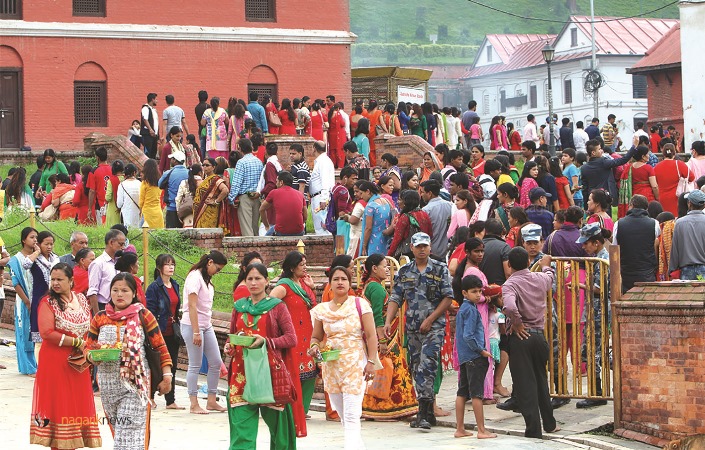Glory Of Shiva In Shravan

Dr. Milan Kumar Thapa
Among many shivalayas (temples and places where Shiva is worshipped) situated in the country, the Temple of Pashupatinath in the capital city is the centre of attraction to all the Hindu devotees. Since ancient times, Pashupatinath has been worshipped as the most prominent form of Aradhya Dev ( the main deity of worship), Lord Shiva.
The Pashupatinath Temple is also considered one of the most pious and holy religious shrines for all the followers of Sanatan belief around the world. The temple and areas of Pashupatinath are always crowded with devotees throughout the year but on the auspicious periods such as the Nepali month of Shravan, Shivaratri and Teej, the temple and the surrounding areas turn into a lively place as massive fetes take place during these times.
Five Mondays
Even out of many Mondays, the five mondays of the month of Shravan are the most valued ones to worship Shiva because the five Mondays of this month hae special elements (tattvas) which can be explained as:
The five Mondays (pancha tattva): Sun (Surya),Sky (Aakash), Wind (Vayu), Water (Jal) and Earth (prithvi).
The five Mondays have also their bearing on- Religion (Dharma) Karma ( Action) Essence (Artha), Lust (Kama) and Liberation (moksha).
The five Mondays also carry with them the five elements such as Health (nirogi), Peace (Shanti), Knowledge (Vidhya), Wealth (Dhana and Son (putra)
Five Mondays also signifie- Sky (Srishti Karta), Moon (Gyan Karta)Brahma, Shivam (Moksha Karta), Sun (Dhan Karta) , Rudra form (Naas Karta)
Five Mondays have significance of having , power of voice (Prana Vayu), digestion, indigestion (Agni Vayu), excretion system (Gude Vayu), systematic functioning of the body (Samman Vayu) and sensory perception of hunger and thirst (Udana Vayu).
The power of Shiva or ( Shiva Shakti) to connect the Five Mondays manifests Him as being the ultimate creator of this world. Therefore, Lord Shiva is worshipped as a gesture of gratefulness, gratitude and appreciation in the month of Shravan.
Specific Days
On every Falgun Chaturdashi, Shivaratri (the Night of Lord Shiva) is celebrated because on this day, Lord Shiva was born. The Hindu and, especially, the Shiva devotees from every corner of the world rejoice and gather at and around the Pashupatinath Temple to celebrate the day with a feeling of satisfaction, religious fulfillment and triumph.
In Hinduism, there is specific dates, days, tithis and pakshas for worshipping every divinity. Ekadashis is the time for woshipping Tulasi plant ( Holy Basil) and Lord Vishnu, Tuesdays for worshipping Lord Ganesh, Sundays for the Sun god. Likewise, Mondays are considered as most propitious days for worshipping Lord Shiva. Many images of Lord Shiva deptics Him wearing various jewels and ornaments and, among them, is a crescent moon is seen on his head. Lord Shiva is highly regarded as the form of Vayu ( Lord of Winds) but moon signifies that it is on the top of Vayu. However, it is also believed that moon can't exist without Vayu. Since moon is on Lord Shiva's head, he is also known as Lord Somnath or the possessor of the moon itself. He is thus closely related to the moon, nature , snake (naag) and the Ganga. Moreover, he is connected to the crescent moon by various means and ways. And becasue of this connection, Lord Shiva is worshipped on Mondays. The auspicious month of Shravan is marked by a complete devotion to Him.
During the month of Shravan, nature itself transforms completely into possessing greenery which is the reason that all the women wear green clothes, bangles and Jewelry during the month. They also observe fast and pray for the happiness and prosperity for their families and relatives.
Gods Vs. Demons
Farmers worship the river Ganga ( name derived from famous river Ganges). The river, in Hindu mythology, is believed to have originated from the head of Lord Shiva. People also worship Lord Shiva for good health and well-being which is why he is also called Baidyanath.
According to our mythology, the gods and demons decided to churn the ocean (an act known as Samudra Manthan) to get Amrit (elixir) from it. Along with elixir, poison also came out during the churning of the ocean. The poison had the potential to destroy the world. However, Lord Shiva drank that poison. Immediately after drinking the poison, the Kalkuta Naag perched on his neck and thus diminished the effect of the poison on Him. With his act of drinking fatal poison, he has actually saved the world, so he is also known as ‘Nil Kantha' becasue of the placing of the poison in his throat.
According to Hindy Jyotish Shastra or Astrology,there is a Kaal Sarpa yoga beset to all human beings. Becasue of this the Hindu people observe the day of Naag Panchami when naag is worshipped and milk is conferred to snake( naag) . The Naag is worn by Lord Shiva around his neck and since Shiva is related to Mondays, the nag puja is also generally done on mondays.
(Dr. Thapa is treasurer of Pashupati Area Development Trust)
Recent News

Do not make expressions casting dout on election: EC
14 Apr, 2022
CM Bhatta says may New Year 2079 BS inspire positive thinking
14 Apr, 2022
Three new cases, 44 recoveries in 24 hours
14 Apr, 2022
689 climbers of 84 teams so far acquire permits for climbing various peaks this spring season
14 Apr, 2022
How the rising cost of living crisis is impacting Nepal
14 Apr, 2022
US military confirms an interstellar meteor collided with Earth
14 Apr, 2022
Valneva Covid vaccine approved for use in UK
14 Apr, 2022
Chair Prachanda highlights need of unity among Maoist, Communist forces
14 Apr, 2022
Ranbir Kapoor and Alia Bhatt: Bollywood toasts star couple on wedding
14 Apr, 2022
President Bhandari confers decorations (Photo Feature)
14 Apr, 2022











